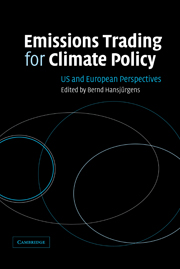Book contents
- Frontmatter
- Contents
- List of figures
- List of tables
- List of contributors
- Preface
- List of abbreviations
- 1 Introduction
- Part 1 Regulatory instruments for climate policy: theoretical aspects
- Part 2 The US approach to pollution control: lessons for climate policy
- Part 3 European policies to control greenhouse gases: the EU directive on emissions trading
- 14 Concluding observations
- Index
- References
1 - Introduction
Published online by Cambridge University Press: 22 September 2009
- Frontmatter
- Contents
- List of figures
- List of tables
- List of contributors
- Preface
- List of abbreviations
- 1 Introduction
- Part 1 Regulatory instruments for climate policy: theoretical aspects
- Part 2 The US approach to pollution control: lessons for climate policy
- Part 3 European policies to control greenhouse gases: the EU directive on emissions trading
- 14 Concluding observations
- Index
- References
Summary
Climate policy and emissions trading after Kyoto
The 1997 Kyoto Conference ushered in a new direction in the discussion of climate protection. Its final document, the Kyoto Protocol to the Framework Convention on Climate Change, assigned in 1997, established “quantified emission limitation and reduction commitments” to OECD countries and some economies in transition (“Annex I countries”). This heralded a completely new tack in climate policy: whereas the need to cut greenhouse gas emissions had already been acknowledged at the United Nations World Summit in Rio de Janeiro in 1992, it was only at the Kyoto Conference that specific reduction targets for signatory countries were laid down for the first time.
Another fresh direction brought about by the Kyoto Protocol was the introduction of new policy instruments for climate protection, namely the Clean Development Mechanism, Joint Implementation, and emissions trading (ET). Since then emissions trading, in particular, has become a widely discussed instrument for climate policy. One reason for the attention emissions trading has received is that it had already been the subject of intense debate in the United States owing to the introduction of several national US programs in the early 1980s and 1990s (see below).
Ever since the Kyoto Protocol was signed, intensive discussion has raged over the need to comply with the Protocol, strategies for doing so, and the details of these new instruments for climate protection. Recent developments have revealed interesting features in US and European climate policy.
- Type
- Chapter
- Information
- Emissions Trading for Climate PolicyUS and European Perspectives, pp. 1 - 14Publisher: Cambridge University PressPrint publication year: 2005
References
- 2
- Cited by

